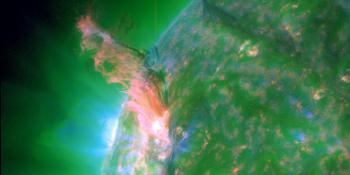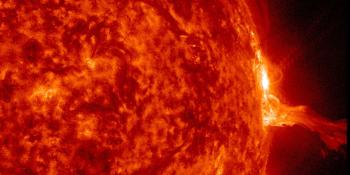Prohlížíte si archiv čtvrtek 22. května 2025
Daily bulletin on solar and geomagnetic activity from the SIDC
Vydáno: 2025 May 22 1231 UTC
SIDC Forecast
Sluneční erupce
C-class flares expected, (probability >=50%)
Geomagnetism
Moderate (ISES: Major) magstorm expected (A>=50 or K=6)
Sluneční protony
Warning condition (activity levels expected to increase, but no numeric forecast given)
| 10cm flux | Ap | |
|---|---|---|
| 22 May 2025 | 120 | 010 |
| 23 May 2025 | 121 | 030 |
| 24 May 2025 | 122 | 008 |
Solar Active Regions and flaring
Solar flaring activity over the last 24 hours has been low, with only one C-class flare. The strongest flare was a C2.6 flare (SIDC Flare 4431) peaking at 18:07 UTC on May 21, associated with SIDC Sunspot Group 504 (NOAA Active Region 4095, magnetic type beta- gamma). There are currently eight numbered active regions on the solar disk. The most complex one is SIDC Sunspot Group 504 (NOAA Active Region 4095). SIDC Sunspot Group 497 (NOAA Active Region 4089) has decayed into plage. SIDC Sunspot Group 505 (magnetic type beta) has rotated on disk from the east limb, in the southeast quadrant. The solar flaring activity is expected to be low to moderate over the next 24 hours, with C-class flares expected and a chance for M-class flares.
Vyhazování koronální hmoty
A Coronal Mass Ejection (CME), SIDC CME 503, was observed in LASCO/C2 coronagraph imagery around 14:06 UTC on May 21, propagating to the west. It is likely a backsided event and it is not expected to impact Earth. A filament eruption was observed in SDO/AIA 304 data around 18:45 UTC on May 21, near SIDC Sunspot Group 502 (NOAA Active Region 4094). No associated CME was observed in the available coronagraph imagery. No other Earth-directed CMEs were observed in the available coronagraph imagery.
Koronální díra
A northern, equatorial, positive polarity coronal hole (SIDC Coronal Hole 115) is crossing the central meridian. An associated, mild high-speed stream may arrive at Earth starting from May 25. The elongated, mid-latitude, positive polarity coronal hole (SIDC Coronal Hole 104) continues to cross the central meridian since May 15.
Solární bouře
The solar wind conditions (ACE and DSCOVR) were enhanced during the past 24 hours, most likely due to the continuous influence of a high- speed stream from the southern, positive polarity coronal hole (SIDC Coronal Hole 104). The solar wind speed decreased from around 620 km/s to around 515 km/s. The interplanetary magnetic field values ranged from 4 nT to 9 nT. The Bz component ranged between -3 nT and 6 nT. The interplanetary magnetic field angle phi was predominantly in the positive sector. Further enhancements in the solar wind conditions may be expected over the next 24 hours, due to the possible arrival of a glancing blow associated with the Coronal Mass Ejection observed around 00:24 UTC on May 19 (SIDC CME 500), and the continuous influence of the high-speed stream from the southern, positive polarity coronal hole (SIDC Coronal Hole 104).
Geomagnetism
Geomagnetic conditions globally were quiet levels (NOAA Kp 1+ to 2+) over the past 24 hours. Geomagnetic conditions locally were at quiet levels (K BEL 2) over the past 24 hours. Active to minor storm conditions, with a chance for isolated moderate storm intervals (NOAA Kp 4 to 6) are expected over the next 24 hours due to the possible arrival of a glancing blow associated with the Coronal Mass Ejection observed around 00:24 UTC on May 19 (SIDC CME 500), and the continuous influence of the high-speed stream from the southern, positive polarity coronal hole (SIDC Coronal Hole 104).
Proton flux levels
The greater than 10 MeV proton flux was below the 10 pfu threshold over the past 24 hours. It is expected to remain below the threshold level over the next 24 hours, pending no further eruptive activity from SIDC Sunspot Group 504 (NOAA Active Region 4095, magnetic type beta-gamma).
Electron fluxes at geostationary orbit
The greater than 2 MeV electron flux measured by GOES 18 was over the 1000 pfu threshold between 17:00 UTC and 23:30 UTC on May 21. The greater than 2 MeV electron flux measured by GOES 19 was close to the 1000 pfu threshold but remained below it in the past 24 hours. The greater than 2 MeV electron flux is expected to be above the 1000 pfu threshold over the next 24 hours. The 24-hour electron fluence is presently at normal levels and is expected to remain so over the next 24 hours.
Today's estimated international sunspot number (ISN): 103, based on 15 stations.Solar indices for 21 May 2025
| Wolf number Catania | /// |
| 10cm solar flux | 119 |
| AK Chambon La Forêt | 014 |
| AK Wingst | 014 |
| Estimated Ap | 016 |
| Estimated international sunspot number | 098 - Based on 26 stations |
Noticeable events summary
| Day | Begin | Max | Konec | Loc | Strength | OP | 10cm | Catania/NOAA | Radio burst types | |
|---|---|---|---|---|---|---|---|---|---|---|
| Žádný | ||||||||||
Provided by the Solar Influences Data analysis Center© - SIDC - Processed by SpaceWeatherLive
Všechny časy v UTC
<< Přejít na stránku s denním přehledem
Poslední zprávy
Nejnovější zprávy na fóru
Podpora SpaceWeatherLive.com!
Mnoho lidí přichází do SpaceWeatherLive, aby sledovali aktivitu Slunce nebo pokud je vidět polární záři, ale s větším provozem přicházejí i vyšší náklady na server. Zvažte dar, pokud vás baví SpaceWeatherLive, abychom mohli udržovat web online!

Fakta o počasí ve vesmíru
| Poslední X-záblesk | 14. 05. 2025 | X2.7 |
| Poslední M-záblesk | 21. 05. 2025 | M1.2 |
| Poslední geomagnetická bouře | 17. 05. 2025 | Kp6+ (G2) |
| Dny bez skvrn | |
|---|---|
| Poslední den bez skvrn | 08. 06. 2022 |
| Průměrný měsíční počet slunečních skvrn | |
|---|---|
| dubna 2025 | 140.6 +6.4 |
| května 2025 | 70.9 -69.7 |
| Posledních 30 dnů | 85.8 -27.8 |


